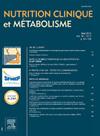Neurological level, acceptance of the modified diet, nutritional and water status after stroke
IF 0.5
4区 医学
Q4 ENDOCRINOLOGY & METABOLISM
引用次数: 0
Abstract
Introduction
Individuals affected by cerebrovascular accident (CVA) may present oropharyngeal dysphagia, which may lead to dehydration and nutritional deficiencies.
Objective
Assess the influence of the neurological level after the CVA in the acceptance of the modified food consistency after speech-language pathology assessment, consequently, in the nutritional and water status, in individuals assisted by an interdisciplinary team.
Methodology
Longitudinal observational study developed in a general hospital with nutritional assessments in three different times, obtaining BMI and body analysis by BIA. Dietary acceptance was quantified daily during hospitalization and sodium test results were evaluated as an indicator of hydration level. Data were statistically analyzed using Spearman's correlation coefficient, ANOVA test, and also the Bonferroni and paired T student. A significance level of 5% was considered for inferential analyses and the confidence interval was 95%.
Results
Sample composed predominantly of elderly males. No correlations were found between the change in food consistency and nutritional and water status, oral intake and food acceptance of the individuals, but a statistically significant difference in the variables NIHSS and BIAMM% was observed. Over time, the average course level decreased and the average bioelectrical impedance at time 2 was higher than that at time 3. There wasn’t a significative correlation between water status and neurological level.
Conclusion
No influence of the neurological level after stroke was observed on the acceptance of the modified diet or nutritional and hydration status. However, when the variables were analyzed in isolation a decrease in NIHSS values and muscle loss (BIAMM%) was observed.
脑卒中后的神经水平、改良饮食的接受程度、营养和水分状况
受脑血管意外(CVA)影响的个体可能出现口咽吞咽困难,这可能导致脱水和营养缺乏。目的通过跨学科团队的辅助,评估CVA后神经学水平对言语语言病理评估后接受改良食物一致性的影响,从而对营养和水分状况的影响。方法在某综合医院开展纵向观察研究,在三个不同时间进行营养评估,获得BMI和BIA分析。住院期间每日量化饮食接受度,并评价钠试验结果作为水合水平的指标。数据采用Spearman相关系数、ANOVA检验及Bonferroni和配对T学生进行统计学分析。考虑5%的显著性水平进行推理分析,置信区间为95%。结果样本以老年男性为主。食物稠度的变化与营养和水分状况、口服摄入量和个体的食物接受度之间没有相关性,但变量NIHSS和BIAMM%的差异有统计学意义。随着时间的推移,平均课程水平下降,时间2的平均生物电阻抗高于时间3。水状态与神经学水平无显著相关。结论脑卒中后神经功能水平对改良饮食的接受程度及营养水合状况无明显影响。然而,当单独分析这些变量时,观察到NIHSS值和肌肉损失(BIAMM%)的下降。
本文章由计算机程序翻译,如有差异,请以英文原文为准。
求助全文
约1分钟内获得全文
求助全文
来源期刊

Nutrition Clinique et Metabolisme
医学-内分泌学与代谢
CiteScore
0.80
自引率
16.70%
发文量
216
审稿时长
78 days
期刊介绍:
Nutrition Clinique et Métabolisme is the journal of the French-speaking Society of Enteral and Parenteral Nutrition. Associating clinicians, biologists, pharmacists, and fundamentalists, the articles presented in the journal concern man and animals, and deal with organs and cells. The goal is a better understanding of the effects of artificial nutrition and human metabolism. Original articles, general reviews, update articles, technical notes and communications are published, as well as editorials and case reports.
 求助内容:
求助内容: 应助结果提醒方式:
应助结果提醒方式:


